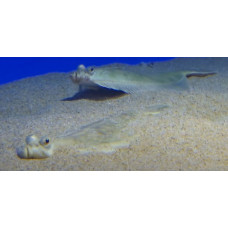Latin name
Pleuronectes platessa
Other names
Plaice
Identification
The adult body shape is oval, with the body strongly compressed in the dorsoventral direction. The head is small, less than a quarter of the length of the entire fish. A small mouth is located at the front of the head, with the upper jaw just below the right eye. Both eyes are on the right side of the body, with a bony ridge behind them (a distinctive feature of this species). The lateral line runs just above the pectoral fin. The skin is smooth and even with small scales.
Features of fish fins
The anal fin has 48 to 61 soft rays, the dorsal fin 65 to 84 soft rays, the pectoral fin 7 to 14 soft rays and the ventral fin 6 soft rays.
Fish colouring
The eye side of the body is olive brown with conspicuous random orange or yellow spots. The blind side of the body is white.
Distribution
Widespread in the eastern Atlantic from the Barents Sea to the Mediterranean, found in the coastal waters of Greenland.
Habitat
Marine, benthic fish. It inhabits sandy and muddy bottoms on the continental shelf, more often at shallow depths (10-50 m); during the day it tries to hide from predators by burrowing into the sediment. Sometimes it can dive to deeper layers (up to 200 metres). Juveniles stay close to the shore in shallow water. The fish can tolerate wide fluctuations in salinity and can survive in low salinity and even freshwater.
Size
Maximum length can reach 1 metre, average length is 50-60 cm. The highest recorded body mass is 7 kg. Life expectancy is up to 50 years.
Behavior
Young immature individuals inhabit shallow coastal beaches, with the youngest fish living near the water's edge and in shoals. During the first year of life, immature fish remain in shallow water for up to 7 months. Occasionally older fish (l+ and ll+) may be seen in such areas, but these are rare.
Food and feeding habits
Most active during the day. Diet consists mainly of polychaetes, crustaceans and bivalves. Juveniles (1-2 years old) feed on shrimps and other small crustaceans.
Reproduction
The main spawning grounds in the North Sea are in the areas of the Southern Bight and east of the English Channel. Females reach sexual maturity at 3-7 years of age (more commonly 3-4 years in the North Sea). Egg development takes place from August to September and December to May. Eggs are released in batches over 3-5 days. Fecundity ranges from 24 to 600,000 eggs, depending on the age and size of the individuals, and varies considerably from year to year. The incubation period is 30-45 days, depending on water temperature. The larvae are planktonic. 40-45 days after hatching, metamorphosis begins, resulting in asymmetry.
Fishing
It is a valuable commercial fish. It is fished with bottom trawls.
Relationship with a person
It is very popular in cooking.
Interesting facts
European plaice have eyes on the top of their heads. This allows them to see enemies and prey swimming above them. Interestingly, when they are juveniles, their eyes are positioned like those of most fish. At this time, plaice live in the water column, feeding on zooplankton. Later they switch to feeding on worms, molluscs and sometimes fish. The left side starts to grow faster than the right side, the left eye moves to the right side, the body becomes flat and eventually both eyes are on the right side. When the transformation is complete, the European plaice sinks to the bottom and lies on its left side. Plaice eyes have another peculiarity. They can turn in different directions independently. This allows the fish to watch for approaching prey or enemies on both sides at the same time.
| Classification | |
| Phylum | Chordata |
| Class | Actinopterygii |
| Squad | Pleuronectiformes |
| Family | Pleuronectidae |
| Genus | Pleuronectes |
| Species | P. platessa |
| Features | |
| Conservation status | Least Concern |
| Habitat | Bottom |
| Life span, years | 50 |
| Maximum body weight, kg | 7 |
| Maximum length, cm | 7 |
| Sailing speed, m/s | No information |
| Threat to people | Edible |
| Way of eating | Predator |
European plaice
Tags: european plaice



